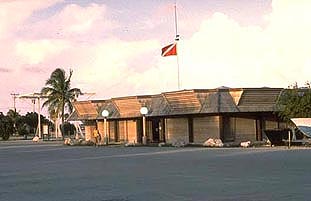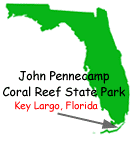
Reservations for
Florida State
Parks are now
made through
Reserve America,
toll free, at
1-800-326-3521
|
JOHN PENNEKAMP CORAL REEF STATE PARK
 The first undersea park in the United States, John Pennekamp Coral Reef State Park, and the adjacent Florida Keys National Marine Sanctuary, cover approximately 178 nautical square miles of coral reefs, seagrass beds and mangrove swamps. The park extends 3 miles into the Atlantic Ocean and is approximately 25 miles in length. These areas were established to protect and preserve a portion of the only living coral reef in the continental United States. The first undersea park in the United States, John Pennekamp Coral Reef State Park, and the adjacent Florida Keys National Marine Sanctuary, cover approximately 178 nautical square miles of coral reefs, seagrass beds and mangrove swamps. The park extends 3 miles into the Atlantic Ocean and is approximately 25 miles in length. These areas were established to protect and preserve a portion of the only living coral reef in the continental United States.
The park is named for the late John D. Pennekamp, a Miami newspaper editor, whose efforts contributed to the establishment of Everglades National Park and the preservation of what would become John Pennekamp Coral Reef State Park.
GEOGRAPHY
The park contains a wide variety of tropical vegetation, shore birds and marine life. And while the mangrove swamps and tropical hammocks offer visitors a unique and interesting experience, it is the coral formations and associated marine life that most park visitors come to enjoy. The coral reefs at John Pennekamp Coral Reef State Park are among the most beautiful and diverse of all living communities.
CORAL REEFS
Coral reefs are living underwater communities which provide food, shelter and breeding areas for many marine plants and animals. These reefs occur only in shallow oceans having clear, warm waters. It has been estimated that Florida's coral reefs have taken 5,000 to 7,000 years to develop. Corals are made up of tiny animals called polyps. Stony corals, such as star and brain coral, secrete a limestone skeleton around their bodies. These skeletons remain after death and provide the foundation for new polyp growth. The building process of stony corals makes up the massive framework of the reef. Octocorals, such as sea fans and sea plumes, don't form hard skeletons. Instead, they are flexible and sway gracefully in the ocean current feeding on plankton. Like the tropical rain forest, the coral reef community is extremely diverse. Living among the corals are sponges, shrimps, crabs, turtles, lobsters and nearly 600 species of fish. Touching or standing on corals may kill them and is therefore prohibited
PARK PROGRAMS
Throughout the year, programs are offered to park visitors on a wide range of natural and cultural history subjects. Guided nature walks along the park's Mangrove and Wild Tamarind trails are offered seasonally or upon request by individuals and organized groups. One trail starts at the parking lot across from the Visitor’s Center and leads through a tropical hammock, home to raccoons and woodland birds. The other, an elevated mangrove trail that begins in the parking lot across from the Picnic Pavilion, offers a close encounter with an array of wading birds – herons, egrets, ducks, cormorants and coots. The park offers interpretive programs, canoe and kayak rentals, boat rentals, and ocean tours.
Nature videos may be viewed in the Visitor Center theater. Ask a Park Ranger for current program schedules or check at the Ranger Station.

John Pennekamp Coral Reef State Park is located at Mile Marker 102.5, north of Key Largo in the Florida Keys.
For more information:
John Pennekamp Coral Reef State Park
P.O. Box 487
Key Largo, FL 33037
(305) 451-1202
View Larger Map
|



